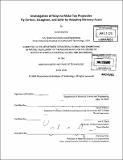Investigation of ways to make toy projectiles fly farther, straighter, and safer by adopting memory foam
Author(s)
Kim, Sunyoung, S.M. Massachusetts Institute of Technology
DownloadFull printable version (18.41Mb)
Other Contributors
Massachusetts Institute of Technology. Dept. of Materials Science and Engineering.
Advisor
David Wallace.
Terms of use
Metadata
Show full item recordAbstract
The purpose of this research has been to improve the performances of toy projectiles by modifying their design. While the developed product is required to comply with all applicable safety specifications and regulations, it is also required to satisfy customers. Through brainstorming, over 30 designs of projectile were generated, 10 models distilled from brainstorming models were prototyped and evaluated through the performance tests. The performance tests involve distance evaluation, accuracy evaluation, safety evaluation, and supplementary evaluation. The distance evaluation is for verifying the performance of flying farther. This test measures flying distance, and initial velocity through high speed imaging, and calculates distance per kinetic energy, and drag coefficient. The accuracy evaluation indicates how accurately the each projectile model is able to fly to the aim, and it is performed by calculating the variance of the lengths between the center of the dart board and the marks which projectiles made when they bumped into the dart board. The safety evaluation is for confirming the compliance of developed models with the safety standard and it achieved with calculating the kinetic energy density. The supplementary evaluation is for comparing the production error and performing error. Through the analysis of performance tests' results, the models were modified and refined from the best performance model. (cont.) The refined models were prototyped and evaluated through the performance tests as well. The refined model #13-1 has the same range of flight and 37.69% better accuracy than the state-of-the-art projectiles, and the refined model #13-3 has the 31.78% longer range of flight and comparable accuracy to the state-of-the-art projectiles. In conclusion, the final model was attained with specific concepts: The surface of the projectile should be smooth without bump between head and body; Two things should be avoided: too high mass because it limits the distance of flight and generates high kinetic energy density, and too low mass because it causes unsatisfied accuracy; The uniform density distribution is desired for straightness of flight; The head of the projectile should be close to streamline; The contact area should be composed with soft material that would be memory foam to protect users from injury; Stiff material not deformed by air pressure should be installed in the head and the shape of the stiff material should not sharp; The occupancy of stiff material's volume in the head should not exceed 25% of the whole volume of the head.
Description
Thesis (S.M.)--Massachusetts Institute of Technology, Dept. of Materials Science and Engineering, 2009. Cataloged from PDF version of thesis. Includes bibliographical references (p. 113).
Date issued
2009Department
Massachusetts Institute of Technology. Department of Materials Science and EngineeringPublisher
Massachusetts Institute of Technology
Keywords
Materials Science and Engineering.